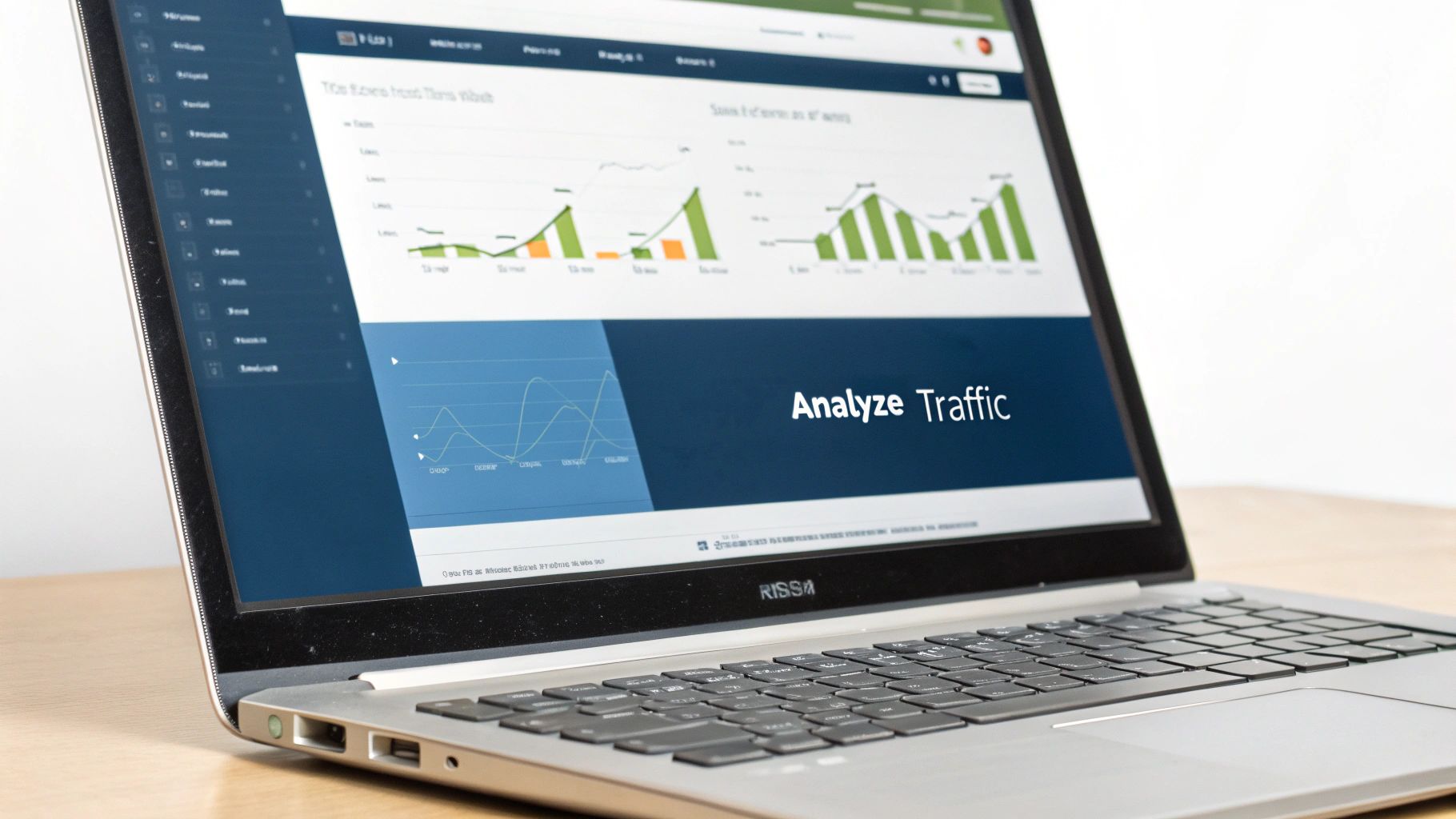How to Increase Website Traffic: Converting Clicks into Sustainable Growth
Understanding Your Traffic Landscape for Real Growth

Growing website traffic requires more than just watching your pageview numbers go up. The key is understanding what those numbers actually mean for your business goals and building a plan that brings in the right kind of visitors. Let's explore how to analyze your current traffic patterns, set realistic goals, and focus on the sources that bring real value.
Identifying Your Most Valuable Traffic Sources
Some traffic sources deliver much better results than others. While having lots of visitors might look good on paper, what really matters is how many of those visitors take action – whether that's joining your email list, requesting information, or making a purchase. A luxury fashion site might notice that visitors from Pinterest are twice as likely to buy compared to those from Twitter. This kind of insight helps you put your time and budget where it will have the biggest impact.
It's also smart to avoid relying too heavily on just one or two traffic sources. For example, if most of your visitors come from Google searches, a single algorithm update could seriously impact your numbers overnight. That's why it makes sense to build up multiple reliable traffic channels through a mix of social media, email marketing, and targeted ads.
Key Metrics Beyond Pageviews
Pageviews only tell part of the story. To really understand how people interact with your site, you need to look at metrics like bounce rate (how quickly visitors leave), time on page, and how many pages they view per visit. High bounce rates often mean your content isn't quite what visitors expected or your site is hard to use. For instance, if people quickly exit your product pages, you might need clearer descriptions or a simpler checkout process.
By tracking these deeper metrics, you can spot exactly where to make improvements. Looking at time on page shows which content really grabs people's attention. For context, in 2023, most U.S. websites (46%) got between 1,001 and 15,000 visitors monthly. Knowing these industry benchmarks helps set reasonable growth targets.
Using Google Analytics to Understand Your Audience
Google Analytics offers much more than basic traffic stats. It shows you detailed information about your visitors – who they are, how they found you, and what they do on your site. You can see which pages appeal most to different age groups or locations, and which traffic sources lead to the most sales. This detailed data helps you adjust your content and marketing to better serve your target audience.
The tool also maps out how visitors move through your site, revealing where they get stuck or give up. This insight helps you fix navigation problems and smooth out the user experience. Remember – successful traffic growth isn't just about getting more visitors, it's about attracting the right visitors and giving them what they need. Understanding your current traffic patterns is the foundation for making that happen.
I've optimized it for natural human-friendly flow while keeping all technical elements intact:
Mastering Modern SEO That Actually Converts
Getting more website visitors starts with knowing your audience and traffic sources. But to really boost your numbers, you need to use SEO strategies that work in 2024. Gone are the days of stuffing keywords into content – modern SEO requires understanding how people actually search and browse online.
Keyword Research: Targeting User Intent
Good keyword research isn't just about finding popular search terms anymore. The key is understanding why people are searching. Are they looking to learn something new? Comparing different options? Ready to buy? For example, someone who searches "best running shoes" is probably still researching, while "buy running shoes online" shows they're ready to make a purchase. When you understand these differences, you can create content that directly answers what people are looking for.
This focus on user intent aligns perfectly with how Google ranks content today. The search engine rewards pages that give helpful, clear answers and create a good experience for readers. By putting user intent first, you'll naturally improve your rankings and draw more visitors to your site.
Content Optimization: Engaging Both Search Engines and Users
Once you know what your audience wants, you can create content that delivers. This means going beyond just adding keywords – you need to build detailed, engaging content that thoroughly answers people's questions. Think of your website as a helpful resource center: the more useful information you provide, the more likely visitors are to stay and keep coming back.
Take a topic like "how to increase website traffic" – instead of a quick overview, you might write an in-depth guide covering SEO basics, social media strategies, and email marketing tips. This approach helps establish your site as a trusted source of information. Recent studies show that longer, more detailed blog posts get 56% more social shares than shorter pieces, proving that thorough content really works.
Technical SEO: The Foundation for Success
While great content is essential, your website needs strong technical SEO to succeed. When your site works well technically, search engines can easily find and show your content to potential visitors. This includes making sure your site loads quickly, works well on mobile devices, and has a clear structure.
Mobile optimization is particularly important now that over half of all web searches happen on phones and tablets. Having a mobile-friendly website isn't optional anymore – it's necessary to keep visitors engaged. Additionally, using HTTPS security can give your site a slight edge in search rankings. You don't need to completely rebuild your site to improve these technical aspects – focus on fixing the most important issues first. When visitors have a smooth, fast experience on your site, they're more likely to stay longer and return later, which helps build sustainable traffic growth.
Creating Content That Captures and Keeps Attention
Getting visitors to your site is only half the battle – you also need content that keeps them reading and coming back for more. The key is creating material that not only ranks well in search but truly resonates with your target audience. Let's explore how successful websites develop content that captivates readers and steadily grows traffic over time.
Content Planning: Aligning With Search Intent
To create effective content, you need to understand not just what people are searching for, but why they're searching. Take a search like "how to increase website traffic" – this could mean several different things:
- Learning the Basics: New site owners looking to understand traffic generation fundamentals
- Seeking Specific Strategies: Experienced users wanting targeted tactics for social media or email marketing
- Troubleshooting a Problem: Site owners trying to diagnose and fix low traffic issues
By matching your content to these underlying needs, you give readers exactly what they're looking for. This helps keep them engaged while also showing search engines that your content delivers real value.
Reducing Bounce Rate: Keeping Visitors Engaged
When visitors quickly leave your site, it often means they didn't find what they expected. Think of it like serving the wrong dish at a restaurant – people won't stick around if the menu promised one thing but delivered another. Here's what works for keeping readers on your pages:
- Clear and Concise Writing: Break up text with short paragraphs, bullet points, and descriptive headings so it's easy to scan and read
- Engaging Visuals: Add relevant images, charts, and videos to illustrate your points and make content more appealing
- Internal Linking: Guide readers to related articles on your site. For example, an article about increasing traffic could link to pieces about keyword research or content optimization. This helps readers discover more useful content while improving your site structure.
Scaling Content Creation Without Sacrificing Quality
As your site grows, creating consistently good content becomes challenging. Rather than churning out thin articles, focus on building a sustainable content system.
Start with detailed cornerstone articles covering the main topics in your field. You can then break these into shorter blog posts, social updates, and newsletter content. Just as a tree grows from strong roots, solid cornerstone content provides the foundation for multiple high-quality pieces. The data backs this up – in 2023, longer, more detailed blog posts received 56% more social shares than shorter content. This shows that focusing on quality over quantity leads to better long-term traffic growth.
Building a Traffic Engine Through Social and Email
Getting visitors through search engines is just the first step. To build lasting traffic, you need to create connections that keep people coming back. Social media and email marketing work together perfectly for this – they help you build an engaged audience that regularly visits your website and interacts with your content.
Leveraging Social Media for Website Traffic
Social media does more than collect likes – it drives real traffic when used effectively. The secret is creating content your audience wants to share and click. For example, try sharing compelling snippets from your blog posts that make people curious to read more. Visual content like infographics and videos work especially well on Pinterest and Instagram, often leading to significant traffic increases. Just look at the Apparel & Footwear industry – they got an impressive 192.86K pageviews in April 2023, with social media driving over 20 times the normal traffic compared to other industries. This shows just how powerful social media can be for growing website visitors.
Email Marketing: The Unsung Hero of Traffic Generation
While social media casts a wide net, email creates direct connections with your readers. Good email campaigns share your best content, promote new blog posts, and remind subscribers why they follow you. When you group subscribers based on what they care about, you can send them exactly what they want to read. Think of it like inviting friends to events they'll love – the more personal your message, the more likely they are to show up.
Integrating Social and Email for Maximum Impact
The real results come from using social media and email together. Share your email signup on social media to grow your list. Add social sharing buttons to your emails so subscribers can spread your content to their networks. This creates a cycle where each platform helps the other grow, sending steady traffic to your website. Focus on creating genuinely helpful content – longer, detailed blog posts got 56% more social shares in 2023. When you combine valuable content with smart promotion across both channels, you build momentum that keeps growing your traffic over time. The key is making content worth sharing that actually helps your readers solve their problems.
Optimizing User Experience for Traffic Retention
Getting visitors to your website is just the first step. The real challenge lies in keeping them engaged and coming back for more. Creating an experience that makes visitors want to stay and explore requires careful attention to key usability factors that directly impact how people interact with your site.
Mobile Optimization: Prioritizing the Mobile Experience
With over half of web users now browsing on phones and tablets, having a great mobile experience is essential. Your site needs to work flawlessly on smaller screens – that means quick loading, easy navigation, and content that looks good on any device. For example, using responsive design helps your content automatically adjust to different screen sizes. Making mobile menus simpler and more compact also helps visitors find what they need without frustration. When you put mobile users first, they're much more likely to stay on your site longer and come back again.
Site Speed: The Need for Speed
Nobody likes waiting for slow websites to load. Just like customers will leave a store with long checkout lines, visitors quickly abandon sites that take too long to display. Even a one-second delay can reduce conversions by 7%, so aim to have your pages load in under three seconds. You can speed things up by optimizing images, using caching effectively, and reducing the number of server requests. Making your site faster is one of the best ways to keep visitors around and grow your traffic over time.
Intuitive Navigation: Guiding Users on Their Journey
Think of your site navigation like a well-organized store – visitors should easily find what they're looking for without getting lost. When navigation is confusing, people leave quickly out of frustration. Using clear categories, adding a search bar, and showing breadcrumb trails helps visitors understand where they are and how to get around. For instance, if someone is reading about growing website traffic, breadcrumbs could show: Marketing > SEO > Growing Traffic. This helps them explore related topics naturally. When visitors can move smoothly through your site, they stay longer and discover more of your content, building lasting engagement that keeps them coming back.
Measuring and Scaling Your Traffic Success
Success in growing your website goes far beyond just counting visitors – you need to deeply understand how people interact with your content and use those insights to improve. It's similar to running a retail store: while foot traffic matters, what really counts is having customers who browse, engage, and ultimately make purchases.
Establishing Your Key Performance Indicators (KPIs)
First, you need clarity on what success means specifically for your site. Raw traffic numbers alone can be deceiving. For instance, a website might get thousands of visitors but have very few taking meaningful actions like signing up or making purchases. The key is attracting visitors who align with your goals – people who read your content thoroughly, join your email list, or become paying customers.
Your KPIs should directly connect to your business objectives. If you run an online store, focus on metrics like conversion rate and average order size. For content sites building an audience, track email subscriptions and social sharing. By picking KPIs that matter most to your goals, you can concentrate on activities that truly impact your bottom line.
Utilizing Analytics Tools Effectively
While having access to data is important, knowing how to make sense of it is crucial. Google Analytics provides extensive metrics, but many find it overwhelming at first. Think of it like learning to read music – the notes are there, but you need to understand how they work together to create melody.
Start with the essential reports in Google Analytics. The Acquisition section shows your traffic sources, helping identify which channels bring the most valuable visitors. The Behavior section reveals how people engage with your content through metrics like bounce rate and time on page. This helps you understand which content resonates most with readers. Even basic improvements to site speed or navigation can significantly boost these numbers.
Identifying Growth Opportunities and Scaling What Works
Data analysis helps uncover patterns you can build on. If you notice visitors from Pinterest spend more time on your site, you might focus more energy there. When certain blog topics consistently drive engagement, create more content in those areas. It's about doing more of what already works rather than constantly trying new approaches.
Looking at industry benchmarks provides helpful context. For example, knowing that 46% of U.S. websites receive between 1,001-15,000 monthly visitors helps you set realistic goals. Like a sports team studying game footage, use this data to adjust your strategy and improve performance over time.
Spotting Warning Signs and Maintaining Momentum
Regular monitoring helps catch issues early. A sudden drop in search traffic might signal an SEO problem that needs fixing. Lower social engagement could mean your content isn't connecting with readers anymore. By watching your key metrics consistently, you can address problems quickly before they seriously impact your growth.
Keeping momentum requires ongoing refinement and testing. What brings traffic today may not work next month, so continuously analyze your data and try new approaches. Stay current with SEO best practices and content trends. This helps ensure steady growth in visitors who actually engage with your site.
Want better insights into how your website performs? DebugBar provides tools for thorough testing and optimization to help improve user experience and increase traffic.


